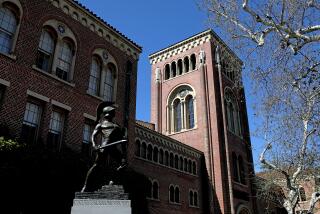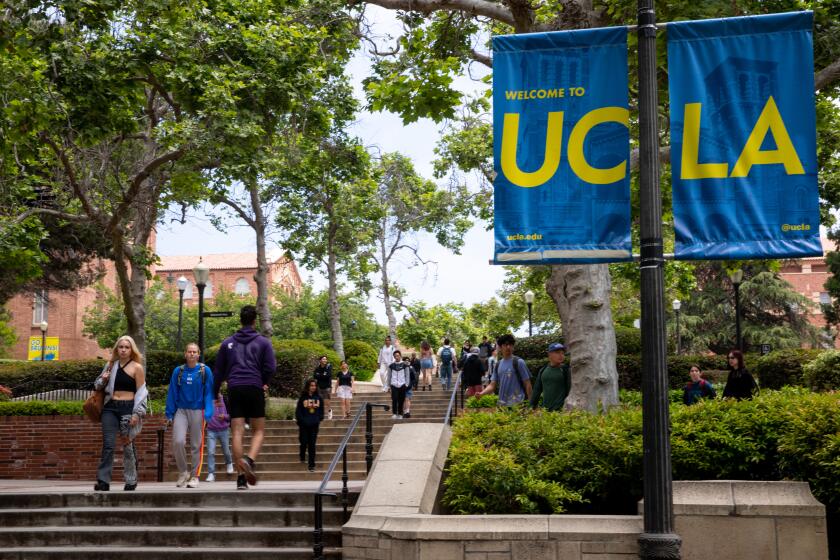Confusion, Anger Building on SDSU Campus Over 10% Cuts
- Share via
There is growing frustration among professors and students at San Diego State University as they face up to a permanent 10% reduction in academic offerings due to the state’s severe money shortage.
University President Thomas Day last month ordered 10% overall cuts throughout the academic colleges. That means the elimination of hundreds of classes and the termination of 500 or more non-tenured faculty members, many of whom have taught at the Montezuma Mesa campus for years.
But the cutbacks are still poorly understood among the 2,000 tenured and temporary faculty members and the more than 30,000 students who cram the campus from early morning until late at night, despite memos and meetings between Day and key professors of the Senate--the body that oversees campus academic matters.
That has led to a plethora of rumors and concerns, from allegations that some departments are being favored over others to simple frustration over whether Day could make the cuts differently and save more of the part-time faculty, who teach many freshmen- and sophomore-level courses.
An ad-hoc group of students and professors--many of the faculty members with close ties to the statewide university teachers union--have called for a daylong walkout from classes today for a rally and teach-in to channel campus dissatisfaction.
About a thousand students have already marched twice in previous weeks to express concern over the looming cuts.
Organizers plan today to talk about statewide and campus budget scenarios, and to seek community support for pressuring state legislators to protect educational funding by supporting new taxes. They also want Day to provide the ad-hoc group with detailed explanations for his planned cuts.
“The reason for the whole movement is that the cuts seemed to have been made as a fait accompli and that there seems to be no way to change any of the decisions,” English professor Larry McCaffrey said. “At the university level, we at least want a way to talk about the way the cuts are being implemented. There is a sense among many that the cuts have not been equal across” the campus.
“At the larger level, we want to draw attention to what the state is doing to education,” he said.
Political science senior Liza Raymond, one of several students heading up the movement, cautioned, “We are not trying to bash President Day. We are trying to go beyond that, to address legislators and say that the proposed cuts are not tolerable considering our future.”
Nevertheless, another co-leader, junior Tim Doring, came away from a small student gathering with Day last week unclear why funds from the university’s foundation, lottery proceeds or parking fees cannot be used to cope with an estimated $19.6-million shortfall needed to continue all present services in next year’s budget. The figure results from various cuts that the board of trustees of the California State University system have mandated for its campuses.
“A lot of students are just confused,” Doring said. “We see (Day) cutting teachers while still constructing buildings.”
University administrators note that funding for construction comes from a separate budget and is not available for salaries and operational expenses.
Day believes the planned cuts are the best way to proceed. While he said he can “understand the frustration and anger of people, and be sympathetic to the impulse (of the rallies), they should not be surprised” given the $12.6-billion budget shortage at the state level.
Day targeted the majority of the university’s approximately 900 non-tenured full- and part-time lecturers for dismissal in order to protect tenured faculty members from layoffs, even though the non-tenured professors teach hundreds of courses throughout the various departments. But because some departments rely more heavily on the non-tenured lecturers than others, the cuts will affect courses in some subjects more than in others.
“After discussions with the Senate people, our priority was to protect the infrastructure for instruction, such as the library, computers,” as well as tenured faculty. Many of the younger professors among them represent the future core of the teaching staff, Day said. Younger, tenured faculty members also represent the bulk of the university’s small number of nonwhite professors.
While he did cut some sports budgets, Day decided not to eliminate the Division 1 level programs in basketball and football “because while I think there should be some (budget) effects on sports, I can’t imagine not having Division 1 football in a city this size.”
And Day said that a 10% cut in top mangement positions, instead of the 5% he has proposed, would be simplistic, because there are less than 80 total positions “and because you can’t just cut out vice presidents or deans . . . how do you run a college without a dean, you can’t just get rid of the college, that would just irritate people even more.”
Day described the result of his plan as one that attempts to maintain quality of instruction for those students who have access to the 90% of the academic content that remains.
“But I am not minimizing or sweeping away the pain this will cause,” he said. “I absolutely agree that some students will take more time to get through here, and some won’t get any of the courses they want next year.”
The president of the Senate, chemistry professor Charles Stewart, said the consensus was to “let go the so-called temporaries, even though a lot of these people are friends and have put in long years of service.”
But to do otherwise, he said, meant “going in narrow and deep” and eliminating whole departments, including both non-tenured and tenured members of the faculty.
“Which departments do you cut?” asked Stewart, recalling that Day took heavy criticism from the faculty in 1979 when, in the midst of cuts forced by passage of the Proposition 13 property tax limitation measure, he suggested eliminating several departments. “And I don’t think we want to do that in a crisis situation, without gathering data to see what departments have strong enrollments” for the future and which do not.
Stewart said that most faculty members disagree with Day’s refusal to use an estimated $1.8 million in lottery funds to cushion the budget blow. Day has set aside the lottery money as a reserve in case the campus ends up needing to cut even more money.
“I’d like to see him give a part of the lottery to help the situation,” Stewart said. As to San Diego State Foundation money, Stewart said he wasn’t certain whether it should target a portion of the annual interest from its $18.7-million endowment for university operations. At present, the foundation uses its income to support student aid, KPBS radio and television and visiting professors, as well as research projects for professors.
“You also can’t expect the foundation to bail out the university’s operations year after year,” Stewart said.
But McCaffery and other professors, while not questioning Day’s sincerity, nevertheless ask why Day has not been more willing to publicly lobby CSU trustees and the legislature for more money, and to speak out more strongly against having to make the level of cuts he has planned.
“I would like to see him negotiate more with the faculty,” said teacher education Prof. David Strom, head of the local California Faculty Assn. unit. “I would like to see him be more creative” by arguing with the Legislature to use parking fees for operations,for example, rather than just “being known as a tough guy.”
Professor Shirley Weber, chairwoman of the Africana Studies department, said that cuts are being made at San Diego State “without any real discussion about student needs . . . nobody considers what the overall campus dropout rate is, or whether we are accountable for teaching well, or giving enough counseling or whatever.”
“There is a sense of frustration, but that is Tom Day’s style” with the faculty, Weber said.
More to Read
Sign up for Essential California
The most important California stories and recommendations in your inbox every morning.
You may occasionally receive promotional content from the Los Angeles Times.










